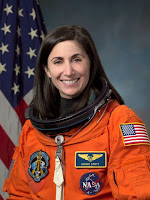NASA Accepting Applications for Aeronautics Scholarship Awards Friday, August 28, 2009 |
NASA's Aeronautics Research Mission Directorate will begin accepting scholarship applications on Sept. 1, 2009, for the 2010 academic year. The application deadline is Jan. 11, 2010.
"These scholarships are a fantastic way to support our brightest students and encourage them to finish their education, expose them to NASA's research programs and inspire them to pursue a career in aeronautics," said Jaiwon Shin, associate administrator for the Aeronautics Research Mission Directorate at NASA Headquarters in Washington.
NASA expects to award 20 undergraduate and five graduate scholarships to students in aeronautics or related fields. Undergraduate students entering their second year of study will receive up to $15,000 per year for two years and the opportunity to receive a $10,000 stipend by interning at a NASA research center during the summer. Graduate students will receive up to $35,000 per annually for up to three years, with an opportunity to receive a $10,000 stipend interning at a NASA research center up to two consecutive summers.
Students who have not committed to a specific academic institution or program still may apply. However, if accepted, they must be admitted by fall 2010 into a suitable aeronautical engineering program or related field of study at an accredited U.S. university. All applicants must be U.S. citizens. Scholarship money may be used for tuition and other school-related expenses.
NASA's Aeronautics Research Mission Directorate conducts cutting-edge, fundamental research in traditional and emerging disciplines. The intent is to help transform the nation's air transportation system and to support development of future air and space vehicles. Goals include improving airspace capacity and flexibility; aviation safety and aircraft performance; reducing overall noise, engine emissions and fuel usage.
For details about this scholarship program, including how to apply, visit:
For more information about NASA's aeronautics programs, visit:
For information about NASA and agency programs, visit:
"These scholarships are a fantastic way to support our brightest students and encourage them to finish their education, expose them to NASA's research programs and inspire them to pursue a career in aeronautics," said Jaiwon Shin, associate administrator for the Aeronautics Research Mission Directorate at NASA Headquarters in Washington.
NASA expects to award 20 undergraduate and five graduate scholarships to students in aeronautics or related fields. Undergraduate students entering their second year of study will receive up to $15,000 per year for two years and the opportunity to receive a $10,000 stipend by interning at a NASA research center during the summer. Graduate students will receive up to $35,000 per annually for up to three years, with an opportunity to receive a $10,000 stipend interning at a NASA research center up to two consecutive summers.
Students who have not committed to a specific academic institution or program still may apply. However, if accepted, they must be admitted by fall 2010 into a suitable aeronautical engineering program or related field of study at an accredited U.S. university. All applicants must be U.S. citizens. Scholarship money may be used for tuition and other school-related expenses.
NASA's Aeronautics Research Mission Directorate conducts cutting-edge, fundamental research in traditional and emerging disciplines. The intent is to help transform the nation's air transportation system and to support development of future air and space vehicles. Goals include improving airspace capacity and flexibility; aviation safety and aircraft performance; reducing overall noise, engine emissions and fuel usage.
For details about this scholarship program, including how to apply, visit:
For more information about NASA's aeronautics programs, visit:
For information about NASA and agency programs, visit:









